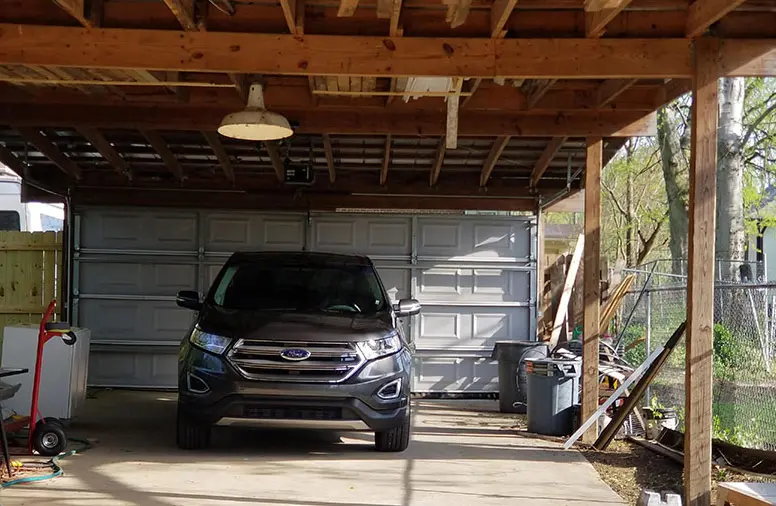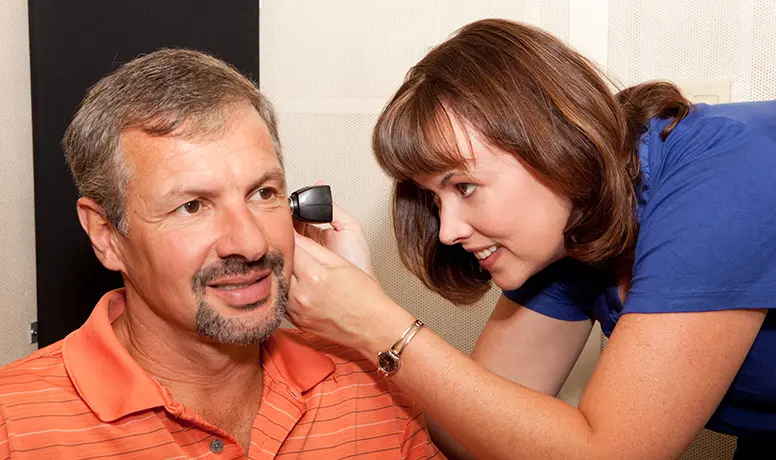I like fantasies as much as the next person, but when I walk into a house I think it should be real. You know, it should actually have walls and such. That’s not what I found when I arrived at a recently renovated AirBnB bungalow. I had spent hours looking through listings to find the perfect place. The lodging looked quaint, and it even had its own garage for secure parking, which was a real selling point for the location. Instead, what I found when I arrived reminds me a lot of what’s wrong with most medical website designs. As I pulled up, everything looked just as it should: the building matched the photos and the garage looked normal…from the outside. Here’s what it looked like when I drove my rental car into the garage.
There was nothing to the garage—it was a facade with no substance. It was like walking up to a Ferrari and opening the hood to find no engine. What a letdown! Garages are more than a parking spot; They serve a function—to keep your car safe. Yet this garage not only wasn’t enclosed, there were loose boards hanging from the ceiling and construction materials lying around.
What does this have to do with website design? Take a look at your website’s data. Your website may be absolutely gorgeous with a slick design, but if it’s not bringing in business for you, it’s completely useless—just fluff without any substance at all. Worse, if it’s not serving three basic functions, it may be losing you patients.
Websites Are More Than a Pretty Design
Your website design should be more than a pretty picture. Every element should be designed to be compelling and persuasive and lead toward the action you want patients to take. It should focus on your patient’s needs, and most important of all, it should be increasing business. Ask yourself, how many new patients has my website generated this month? If your website isn’t generating ten to fifteen new patients a month, it’s just a shell. Pretty, perhaps, on the outside, but useless for attracting new patients or generating phone calls and appointments. Great medical website design should grab the patient’s attention, start to build trust, and encourage them to come meet you in person. MedPB has more than 10 years of experience designing, testing and building medical websites that do just these things, and here’s what we’ve found.
Research Reveals: It’s All About Trust
One of the key findings of a recent report by Yext was that more than 3 quarters of patients search for individual providers when looking for a doctor. They aren’t looking for hospitals or healthcare facilities; They want to know the individual doctor they will be dealing with, and they want to know they can entrust their health and well-being to this person. MedPB’s medical websites go beyond listing staff and specialties. Our web designs focus on the primary concerns of patients—which doctor will I be seeing, and can I entrust my health to them? By focusing on the patient, MedPB’s websites increase patient calls on average 79%.
What could that mean for your practice? “Our Q1 2018 gross revenue is up by 500%, compared to a year ago,” says Lori Klein Gardner, Au.D., of Hear Virginia. “Our Q1 net revenue has tripled, our new appointments have nearly doubled per month.” That’s the power of a customer-focused website. Launch a radically more effective website in just weeks.
Build Your Credibility
In a report by Weatherby Healthcare, patients rated a physician’s knowledge and abilities above all else when deciding which doctor to go to. But how they determine knowledge is often based on reviews and other online sources. More than half of patients research doctors before make making an appointment, and three out of four patients consider reviews important before deciding which doctor to visit. In fact, reviews were just as important to patients as the office location. This trend follows basic consumer behavior: 91% of consumers read reviews before buying something, and 84% of them will trust reviews as much as they would advice from a friend. Many practices know reviews are important, but struggle with getting a steady influx of good reviews. Review tools can not only simplify this process, but get dramatically better results. Rather than trying to get patients to send reviews directly to your site, review software, such as Online Review Builder™, engages patients where they prefer to leave reviews—on social media. Online Review Builder then funnels those reviews back to the practice’s site where new patients are likely to see them. “Our practice has grown 21% in the last year and I attribute 99% of our growth to MedPB’s Online Review Builder™ and our 46 positive Google reviews!” says Gena Marino, Fairfax Hearing Center, VA.
Convert Interest into an Appointment
Once you’ve attracted patients and built up trust and credibility, your website design should encourage them to set up an appointment. This crucial last step actually is an entire science unto itself. Increasing conversions on a site requires a clear hierarchy of information and customer paths that lead to strong calls to action. At the end of the day, what you want customers to do is to call for an appointment. “We’re getting 5 times as many leads from the web, worth $20,000 a month to our practice [since switching over to a MedPB website],” says Sean Pendel, Audiology Associates and Hearing Aids Today of Nashville, TN. Does your website do that? Audit your website today.
Achieve more. Talk to us.



